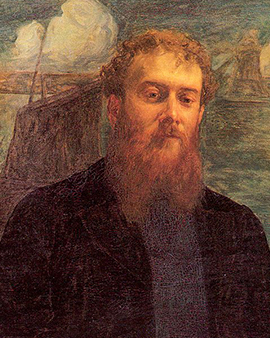In der französischen Republik Mitte des 19. Jahrhunderts, zwischen den Napoleonischen Kriegen und dem Deutsch-Französischen Krieg, machte sich Charles Cottet einen Namen unter den recht zahlreichen und vielfältigen Vertretern des Post-Impressionismus.
Der Sohn eines Richters fand früh den Weg zur Malerei – die gut situierte Familie ermöglichte dem damals 17-Jährigen ein Studium an einer der bekanntesten Kunsthochschulen Frankreichs: Die Ecole des beaux-arts des Paris. Die Tendenz zum Impressionismus und seiner Weiterentwicklung kristallisierte sich bei ihm jedoch erst später heraus. Cottet studierte zunächst das Handwerk verschiedener Strömungen: Von den biblischen Szenerien und Wandgemälden eines Puvis de Chavannes über die beginnend naturalistische Freilichtmalerei von Alfred Philippe Roll bishin zur Academie Julian, an der von den Vertretern der Salon- und Aktmalerei lernte. Die Ecole des beaux-arts des Paris bildete hier das entscheidende Zentrum, in dem ein junger Maler in das Kaleidoskop der bildenden Kunst blicken durfte.
Lange hielt es Cottet nicht in Paris. Vier Jahre nach seinem Studienbeginn bereiste er Holland. Die recht chromatisch, unkonturierte Landschaftsmalerei der dortigen Haager Schule dürfte ihn beeinflusst haben. Insbesondere seine Hafenbilder Anfang des 20. Jahrhunderts erinnern an den teilweise dunklen Duktus dieser Maler. Zwei Jahre später entdeckte er die Bretagne für sich und kehrte viele Male dorthin zurück. Es scheint, als habe Cottet die Eindrücke aus Holland mit dem nachhallend vorherrschenden Impressionismus Frankreichs hier verbinden können, um ein Gefühl des Wohlbekannten, des Ankommenden in seinen Werken zum Ausdruck zu bringen, das sowohl von blinder Freude als auch von einem gewissen Schwermut begleitet sein kann. Der junge Maler aus Frankreich begann, seinen Weg zu finden.
Nahezu schwarze Silhouetten kleiner Boote in einer glasig-fragilen Abendstimmung oder Momentaufnahmen ländlichen Beisammenseins – die erdige, körperreiche Verwurzelung mit dem Land schien er geradezu aus seinen Gemälden heraus meißeln zu wollen. Seine Pinselstriche erinnern an die Skulpturen von Auguste Rodin, dem bekannten zeitgenössischen Bildhauer, mit dem ihn eine Freundschaft verband. Seine kräftig-dunkle Art der Malerei inspirierte. Um ihn bildete sich die „Bande noire“, eine Künstlervereinigung, die dem lichtdurchfluteten Impressionismus einen Kontrast bot. Auch schloss er sich der gleichgesinnten Gruppe „Les Nabis“ an, die sich mit multiplen Kunsttechniken dem Design verschrieb. Obgleich die bretonischen Häfen und Küsten der Mittelpunkt seiner Werke waren, unternahm er zahlreiche Reisen. Sein Hauptmotiv, der Hafen, repräsentiert Cottets Ortsgebundenheit bei gleichzeitigem Fernweh.
Seine künstlerischen und teilweise ethnographischen Verdienste wurden in seinen späteren Jahren ausgezeichnet – darunter auch mit dem französischen Orden eines Offiziers der Ehrenlegion. Cottets schaffensreiches Leben endete schließlich dort, wo seine Karriere einst begann: in Paris.
×





.jpg)
.jpg)
.jpg)
.jpg)
.jpg)
.jpg)
.jpg)
.jpg)
.jpg)
.jpg)
.jpg)
.jpg)
.jpg)
.jpg)
.jpg)
.jpg)
 1907 - (MeisterDrucke-59678).jpg)
 1907 - (MeisterDrucke-59678).jpg)
.jpg)
.jpg)
.jpg)
.jpg)
.jpg)
.jpg)
.jpg)
.jpg)
.jpg)
.jpg)
.jpg)
.jpg)
 - (MeisterDrucke-40119).jpg)
 - (MeisterDrucke-40119).jpg)
.jpg)
.jpg)
_-_(MeisterDrucke-896974).jpg)
_-_(MeisterDrucke-896974).jpg)
.jpg)
.jpg)
.jpg)
.jpg)
.jpg)
.jpg)
.jpg)
.jpg)
_-_(MeisterDrucke-1440286).jpg)
_-_(MeisterDrucke-1440286).jpg)
.jpg)
.jpg)
.jpg)
.jpg)
.jpg)
.jpg)
.jpg)
.jpg)
.jpg)
.jpg)
.jpg)
.jpg)
.jpg)
.jpg)
.jpg)
.jpg)
_-_(MeisterDrucke-36904).jpg)
_-_(MeisterDrucke-36904).jpg)
.jpg)
.jpg)
.jpg)
.jpg)
.jpg)
.jpg)
.jpg)
.jpg)
.jpg)
.jpg)
_-_(MeisterDrucke-1335930).jpg)
_-_(MeisterDrucke-1335930).jpg)
_-_(MeisterDrucke-1318678).jpg)
_-_(MeisterDrucke-1318678).jpg)
.jpg)
.jpg)
.jpg)
.jpg)
.jpg)
.jpg)
.jpg)
.jpg)
.jpg)
.jpg)
.jpg)
.jpg)
.jpg)
.jpg)
.jpg)
.jpg)






